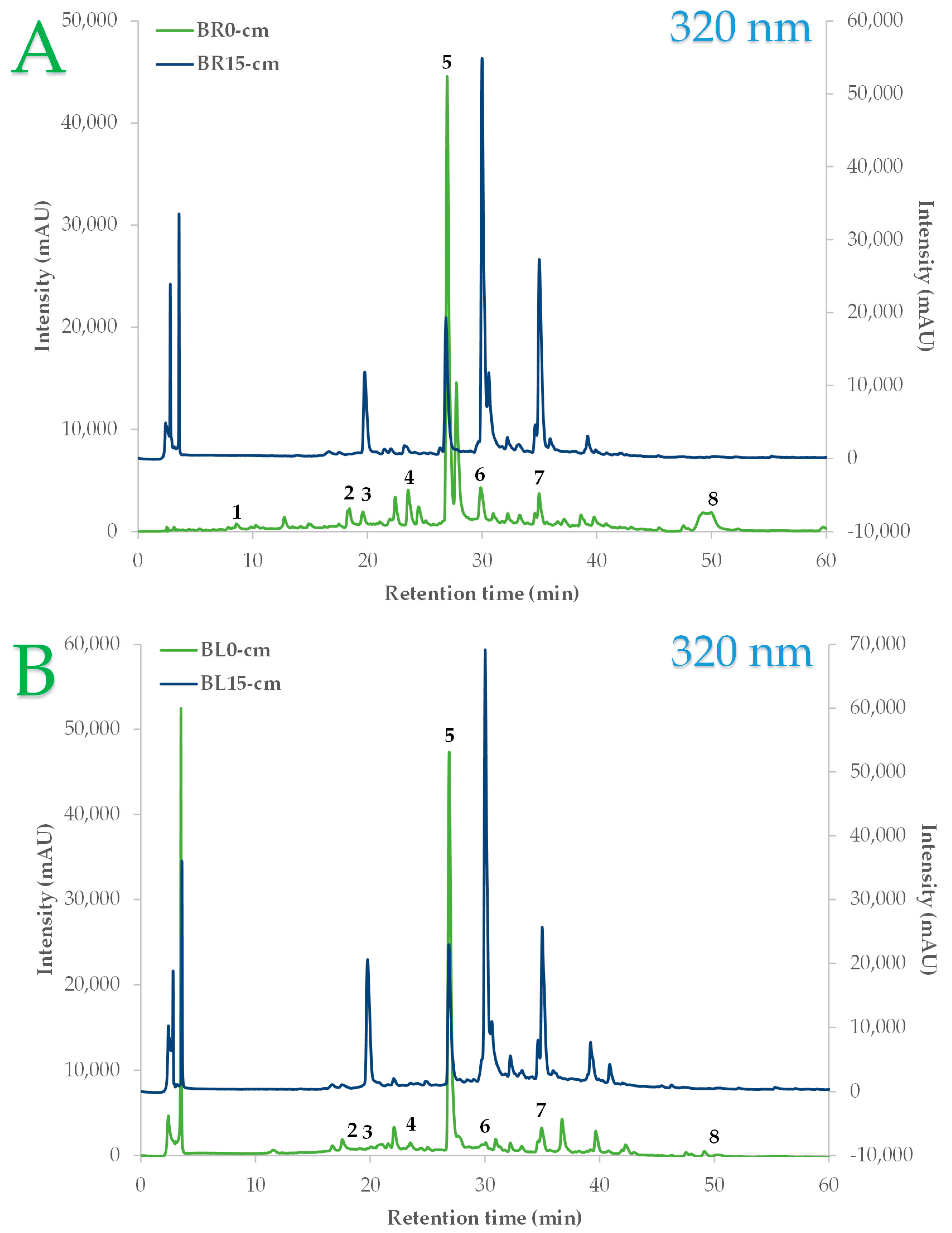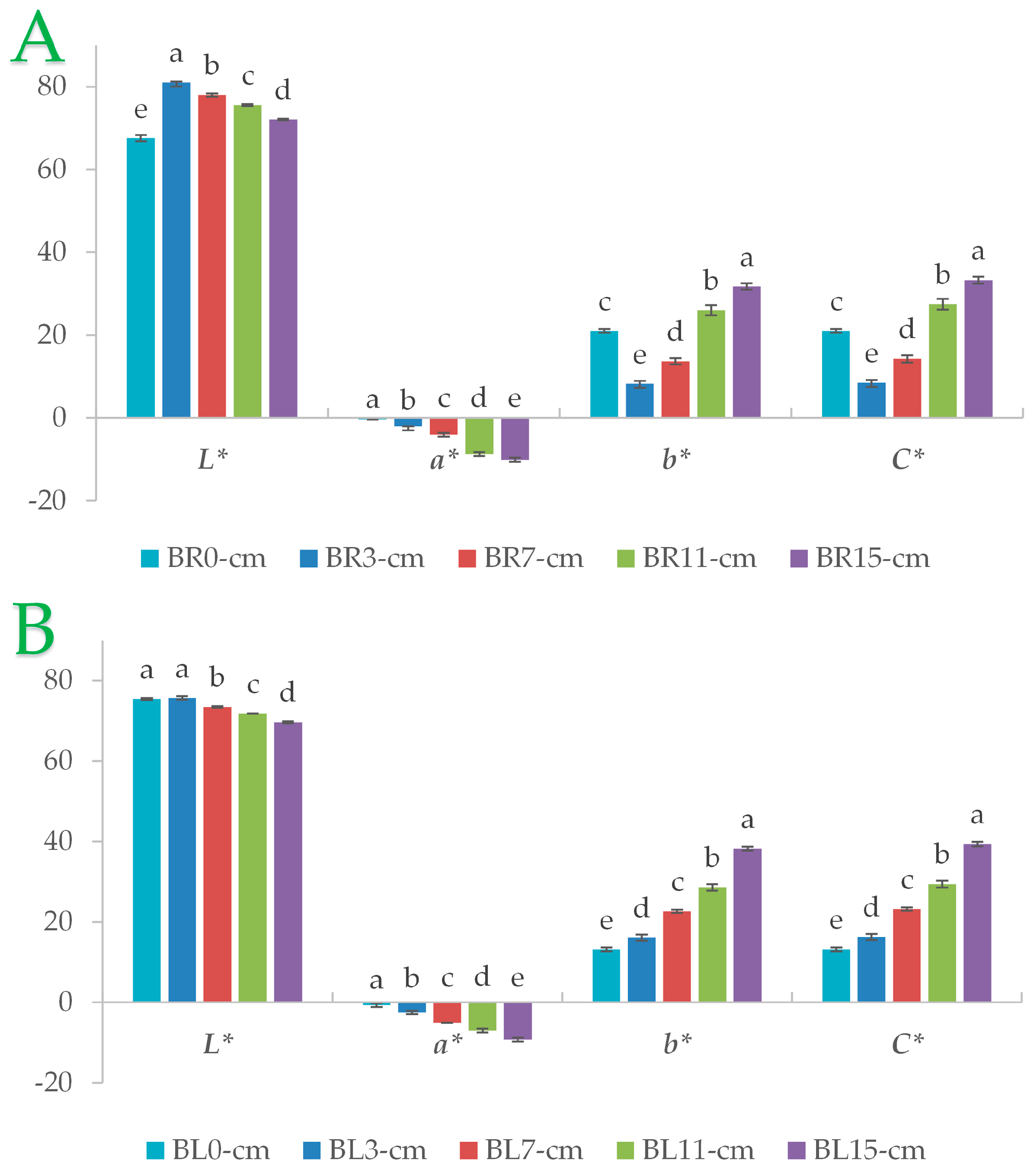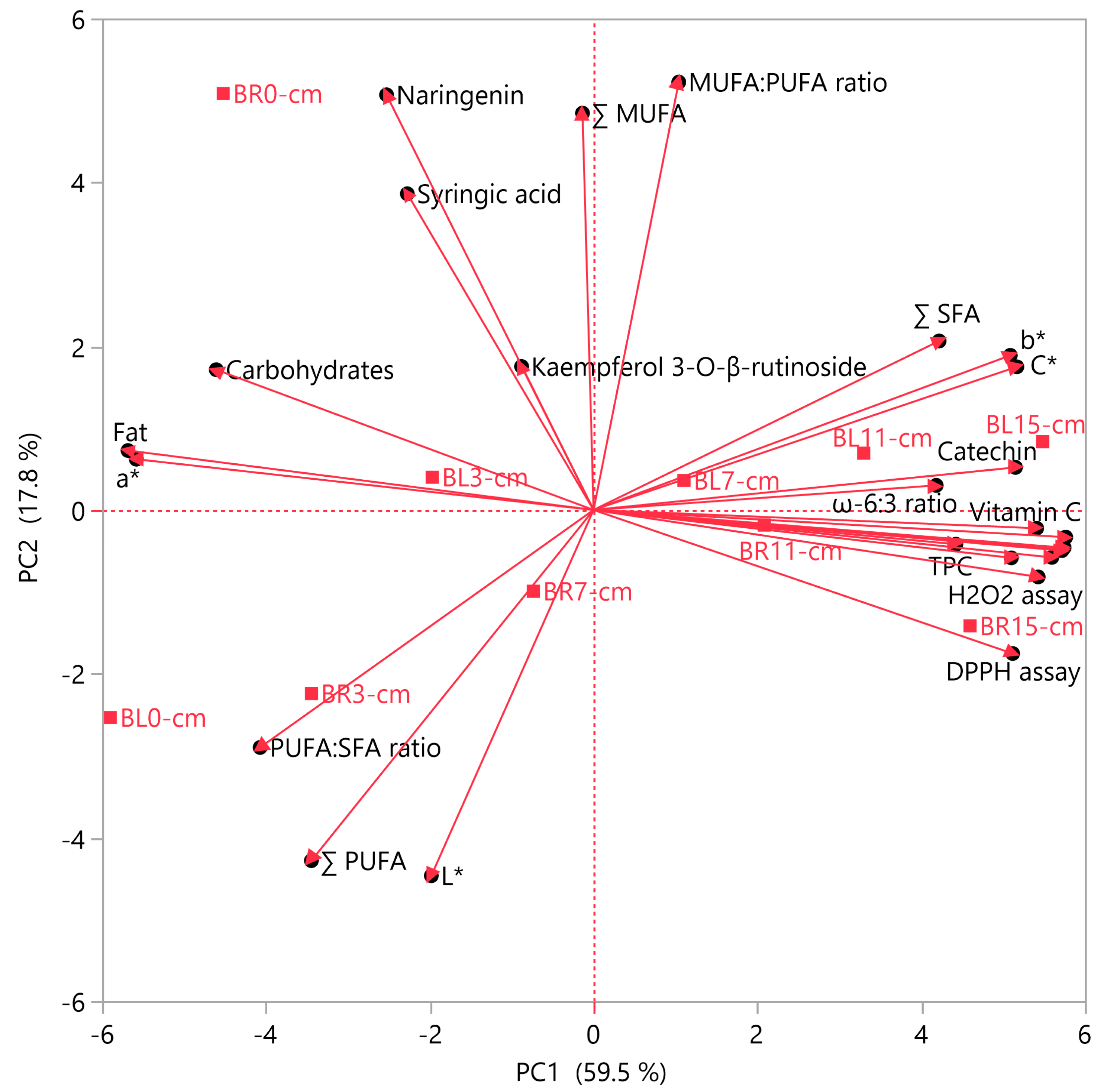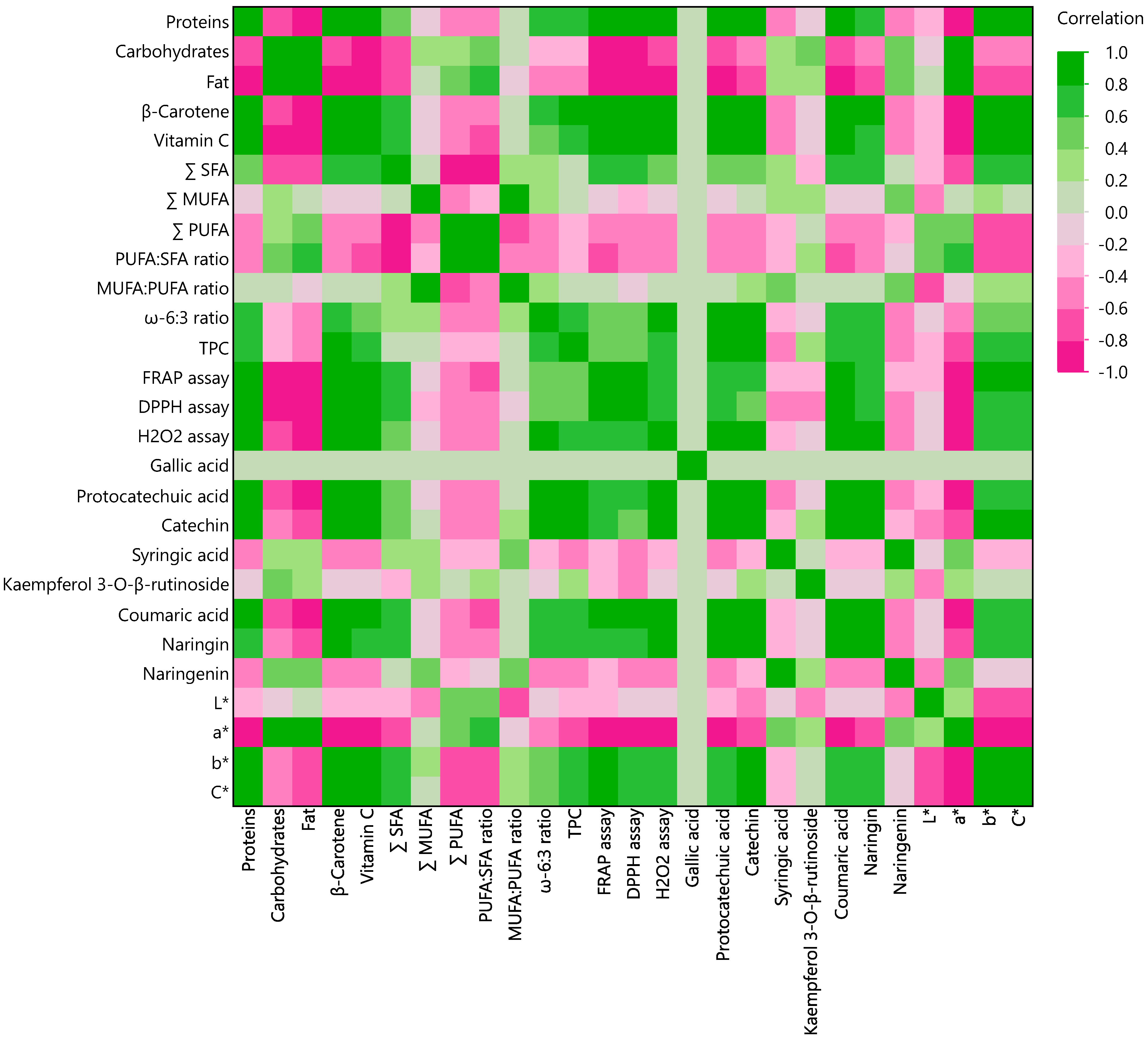Nutritional Quality and Antioxidant Properties of Brown and Black Lentil Sprouts
Abstract
1. Introduction
2. Materials and Methods
2.1. Chemicals and Reagents
2.2. Lentils Germination and Sample Preparation
2.3. Crude Protein Content Determination
2.4. Carbohydrates Content Determination
2.5. Fat Content Determination
2.6. Fatty Acid Composition
2.7. Carotenoids Content Determination
2.8. Vitamin C Content Determination
2.9. Total Polyphenol Content (TPC) Determination
2.10. DPPH Free Radical Scavenging Activity
2.11. Ferric Reducing Antioxidant Power (FRAP) Activity
2.12. Hydrogen Peroxide (H2O2) Scavenging Activity
2.13. HPLC Analysis
2.14. Colorimetry
2.15. Statistical Analysis
3. Results and Discussion
3.1. Nutritional Composition of LS
3.2. Total Polyphenol Content (TPC), Antioxidant Activity, and Color Measurement of LS Extracts
4. Conclusions
Author Contributions
Funding
Data Availability Statement
Conflicts of Interest
References
- Eichelmann, F.; Schwingshackl, L.; Fedirko, V.; Aleksandrova, K. Effect of plant-based diets on obesity-related inflammatory profiles: A systematic review and meta-analysis of intervention trials. Obes. Rev. 2016, 17, 1067–1079. [Google Scholar] [CrossRef] [PubMed]
- Aziz, A.; Noreen, S.; Khalid, W.; Mubarik, F.; Niazi, M.K.; Koraqi, H.; Ali, A.; Lima, C.M.G.; Alansari, W.S.; Eskandrani, A.A.; et al. Extraction of Bioactive Compounds from Different Vegetable Sprouts and Their Potential Role in the Formulation of Functional Foods against Various Disorders: A Literature-Based Review. Molecules 2022, 27, 7320. [Google Scholar] [CrossRef]
- Francis, H.; Debs, E.; Koubaa, M.; Alrayess, Z.; Maroun, R.G.; Louka, N. Sprouts Use as Functional Foods. Optimization of Germination of Wheat (Triticum aestivum L.), Alfalfa (Medicago sativa L.), and Radish (Raphanus sativus L.) Seeds Based on Their Nutritional Content Evolution. Foods 2022, 11, 1460. [Google Scholar] [CrossRef] [PubMed]
- Khang, D.; Dung, T.; Elzaawely, A.; Xuan, T. Phenolic Profiles and Antioxidant Activity of Germinated Legumes. Foods 2016, 5, 27. [Google Scholar] [CrossRef] [PubMed]
- El-Safy, F.; Salem, R.; YY, E.M. The Impact of Soaking and Germination on Chemical Composition, Carbohydrate Fractions, Digestibility, Antinutritional Factors and Minerals Content of Some Legumes and Cereals Grain Seeds. Alex. Sci. Exch. J. 2013, 34, 499–513. [Google Scholar] [CrossRef]
- Siriparu, P.; Panyatip, P.; Pota, T.; Ratha, J.; Yongram, C.; Srisongkram, T.; Sungthong, B.; Puthongking, P. Effect of Germination and Illumination on Melatonin and Its Metabolites, Phenolic Content, and Antioxidant Activity in Mung Bean Sprouts. Plants 2022, 11, 2990. [Google Scholar] [CrossRef]
- Benincasa, P.; Falcinelli, B.; Lutts, S.; Stagnari, F.; Galieni, A. Sprouted grains: A comprehensive review. Nutrients 2019, 11, 421. [Google Scholar] [CrossRef]
- Faris, M.A.-I.E.; Attlee, A. Lentils (Lens culinaris, L.): A novel functional food. In Food Science and Nutrition: Breakthroughs in Research and Practice; Khosrow-Pour, M., Ed.; IGI Global: Hershey, PA, USA, 2018; pp. 361–391. ISBN 9781522552086. [Google Scholar]
- Du, M.; Xiao, Z.; Luo, Y. Advances and emerging trends in cultivation substrates for growing sprouts and microgreens toward safe and sustainable agriculture. Curr. Opin. Food Sci. 2022, 46, 100863. [Google Scholar] [CrossRef]
- Wojdyło, A.; Nowicka, P.; Tkacz, K.; Turkiewicz, I.P. Sprouts vs. Microgreens as novel functional foods: Variation of nutritional and phytochemical profiles and their in vitro bioactive properties. Molecules 2020, 25, 4648. [Google Scholar] [CrossRef]
- Fouad, A.A.; Rehab, F.M.A. Effect of germination time on proximate analysis, bioactive compounds and antioxidant activity of lentil (Lens culinaris medik.) sprouts. Acta Sci. Pol. Technol. Aliment. 2015, 14, 233–246. [Google Scholar] [CrossRef]
- Televičiūtė, D.; Tarasevičienė, Ž.; Danilčenko, H.; Barčauskaitė, K.; Kandaraitė, M.; Paulauskienė, A. Changes in chemical composition of germinated leguminous under abiotic stress conditions. Food Sci. Technol. 2020, 40, 415–421. [Google Scholar] [CrossRef]
- Aslani, Z. Effect of Lentil Sprouts on Glycemic Control in Overweight and Obese Patients with Type 2 Diabetes. Int. J. Nutr. Food Sci. 2015, 4, 10. [Google Scholar] [CrossRef]
- Alkaltham, M.S.; Musa Özcan, M.; Uslu, N.; Salamatullah, A.M.; Hayat, K. Changes in antioxidant activity, phenolic compounds, fatty acids, and mineral contents of raw, germinated, and boiled lentil seeds. J. Food Sci. 2022, 87, 1639–1649. [Google Scholar] [CrossRef] [PubMed]
- Dhull, S.B.; Kinabo, J.; Uebersax, M.A. Nutrient profile and effect of processing methods on the composition and functional properties of lentils (Lens culinaris Medik): A review. Legum. Sci. 2022, 5, e156. [Google Scholar] [CrossRef]
- Nkhata, S.G.; Ayua, E.; Kamau, E.H.; Shingiro, J.B. Fermentation and germination improve nutritional value of cereals and legumes through activation of endogenous enzymes. Food Sci. Nutr. 2018, 6, 2446. [Google Scholar] [CrossRef]
- Jarpa-Parra, M. Lentil protein: A review of functional properties and food application. An overview of lentil protein functionality. Int. J. Food Sci. Technol. 2018, 53, 892–903. [Google Scholar] [CrossRef]
- Gharachorloo, M.; Tarzi, B.G.; Baharinia, M.; Hemaci, A.H. Antioxidant activity and phenolic content of germinated lentil (Lens culinaris). J. Med. Plants Res. 2012, 6, 4562–4566. [Google Scholar] [CrossRef]
- Sharifi-Rad, M.; Anil Kumar, N.V.; Zucca, P.; Varoni, E.M.; Dini, L.; Panzarini, E.; Rajkovic, J.; Tsouh Fokou, P.V.; Azzini, E.; Peluso, I.; et al. Lifestyle, Oxidative Stress, and Antioxidants: Back and Forth in the Pathophysiology of Chronic Diseases. Front. Physiol. 2020, 11, 694. [Google Scholar] [CrossRef]
- Dubois-deruy, E.; Peugnet, V.; Turkieh, A.; Pinet, F. Oxidative stress in cardiovascular diseases. Antioxidants 2020, 9, 864. [Google Scholar] [CrossRef]
- Peñas, E.; Limón, R.I.; Martínez-Villaluenga, C.; Restani, P.; Pihlanto, A.; Frias, J. Impact of Elicitation on Antioxidant and Potential Antihypertensive Properties of Lentil Sprouts. Plant Foods Hum. Nutr. 2015, 70, 401–407. [Google Scholar] [CrossRef]
- Ebert, A.W. Sprouts and Microgreens—Novel Food Sources for Healthy Diets. Plants 2022, 11, 571. [Google Scholar] [CrossRef] [PubMed]
- Prasedya, E.S.; Frediansyah, A.; Martyasari, N.W.R.; Ilhami, B.K.; Abidin, A.S.; Padmi, H.; Fahrurrozi; Juanssilfero, A.B.; Widyastuti, S.; Sunarwidhi, A.L. Effect of particle size on phytochemical composition and antioxidant properties of Sargassum cristaefolium ethanol extract. Sci. Rep. 2021, 11, 17876. [Google Scholar] [CrossRef] [PubMed]
- Makanjuola, S.A. Influence of particle size and extraction solvent on antioxidant properties of extracts of tea, ginger, and tea–ginger blend. Food Sci. Nutr. 2017, 5, 1179. [Google Scholar] [CrossRef] [PubMed]
- Kotsou, K.; Chatzimitakos, T.; Athanasiadis, V.; Bozinou, E.; Adamaki-Sotiraki, C.; Rumbos, C.I.; Athanassiou, C.G.; Lalas, S.I. Waste Orange Peels as a Feed Additive for the Enhancement of the Nutritional Value of Tenebrio molitor. Foods 2023, 12, 783. [Google Scholar] [CrossRef]
- European Union Commission; Commission Regulation (EC); Commission Regulation (EC). No 796/2002 of 6 May 2002 Amending Regulation (EEC) No 2568/91 on the Characteristics of Olive Oil and Olive-Pomace Oil and on the Relevant Methods of Analysis and the Additional Notes in the Annex to Council Regulation (EEC) No 2658/87 on the Tariff and Statistical Nomenclature and on the Common Customs Tariff; European Union Commission: Brussels, Belgium, 2002. [Google Scholar]
- Athanasiadis, V.; Chatzimitakos, T.; Kalompatsios, D.; Palaiogiannis, D.; Makrygiannis, I.; Bozinou, E.; Lalas, S.I. Evaluation of the Efficacy and Synergistic Effect of α- and δ-Tocopherol as Natural Antioxidants in the Stabilization of Sunflower Oil and Olive Pomace Oil during Storage Conditions. Int. J. Mol. Sci. 2023, 24, 1113. [Google Scholar] [CrossRef]
- Athanasiadis, V.; Chatzimitakos, T.; Kotsou, K.; Palaiogiannis, D.; Bozinou, E.; Lalas, S.I. Optimization of the Extraction Parameters for the Isolation of Bioactive Compounds from Orange Peel Waste. Sustainability 2022, 14, 13926. [Google Scholar] [CrossRef]
- Al-Amiery, A.A.; Al-Majedy, Y.K.; Kadhum, A.A.H.; Mohamad, A.B. Hydrogen Peroxide Scavenging Activity of Novel Coumarins Synthesized Using Different Approaches. PLoS ONE 2015, 10, e0132175. [Google Scholar] [CrossRef]
- Chatzimitakos, T.; Athanasiadis, V.; Kotsou, K.; Palaiogiannis, D.; Bozinou, E.; Lalas, S.I. Optimized Isolation Procedure for the Extraction of Bioactive Compounds from Spent Coffee Grounds. Appl. Sci. 2023, 13, 2819. [Google Scholar] [CrossRef]
- Bautista-Expósito, S.; Vandenberg, A.; Peñas, E.; Frias, J.; Martínez-Villaluenga, C. Lentil and Fava Bean with Contrasting Germination Kinetics: A Focus on Digestion of Proteins and Bioactivity of Resistant Peptides. Front. Plant Sci. 2021, 12, 2278. [Google Scholar] [CrossRef]
- Jarpa-Parra, M.; Bamdad, F.; Wang, Y.; Tian, Z.; Temelli, F.; Han, J.; Chen, L. Optimization of lentil protein extraction and the influence of process pH on protein structure and functionality. LWT Food Sci. Technol. 2014, 57, 461–469. [Google Scholar] [CrossRef]
- Ohanenye, I.C.; Tsopmo, A.; Ejike, C.E.C.C.; Udenigwe, C.C. Germination as a bioprocess for enhancing the quality and nutritional prospects of legume proteins. Trends Food Sci. Technol. 2020, 101, 213–222. [Google Scholar] [CrossRef]
- Pal, R.S.; Bhartiya, A.; Yadav, P.; Kant, L.; Mishra, K.K.; Aditya, J.P.; Pattanayak, A. Effect of dehulling, germination and cooking on nutrients, anti-nutrients, fatty acid composition and antioxidant properties in lentil (Lens culinaris). J. Food Sci. Technol. 2017, 54, 909–920. [Google Scholar] [CrossRef]
- Simopoulos, A.P. The importance of the ratio of omega-6/omega-3 essential fatty acids. Biomed. Pharmacother. 2002, 56, 365–379. [Google Scholar] [CrossRef]
- Meléndez-Martínez, A.J.; Mandić, A.I.; Bantis, F.; Böhm, V.; Borge, G.I.A.; Brnčić, M.; Bysted, A.; Cano, M.P.; Dias, M.G.; Elgersma, A.; et al. A comprehensive review on carotenoids in foods and feeds: Status quo, applications, patents, and research needs. Crit. Rev. Food Sci. Nutr. 2022, 62, 1999–2049. [Google Scholar] [CrossRef] [PubMed]
- Gałazka-Czarnecka, I.; Korzeniewska, E.; Czarnecki, A.; Kiełbasa, P.; Drózdz, T. Modelling of carotenoids content in red clover sprouts using light of differentwavelength and pulsed electric field. Appl. Sci. 2020, 10, 4143. [Google Scholar] [CrossRef]
- Li, J.; Lu, Y.; Chen, H.; Wang, L.; Wang, S.; Guo, X.; Cheng, X. Effect of photoperiod on vitamin E and carotenoid biosynthesis in mung bean (Vigna radiata) sprouts. Food Chem. 2021, 358, 129915. [Google Scholar] [CrossRef]
- Carr, A.C.; Maggini, S. Vitamin C and immune function. Nutrients 2017, 9, 1211. [Google Scholar] [CrossRef]
- Chambial, S.; Dwivedi, S.; Shukla, K.K.; John, P.J.; Sharma, P. Vitamin C in disease prevention and cure: An overview. Indian. J. Clin. Biochem. 2013, 28, 314–328. [Google Scholar] [CrossRef]
- Xu, M.J.; Dong, J.F.; Zhu, M.Y. Effects of germination conditions on ascorbic acid level and yield of soybean sprouts. J. Sci. Food Agric. 2005, 85, 943–947. [Google Scholar] [CrossRef]
- Idowu, A.T.; Olatunde, O.O.; Adekoya, A.E.; Idowu, S. Germination: An alternative source to promote phytonutrients in edible seeds. Food Qual. Saf. 2020, 4, 129–133. [Google Scholar] [CrossRef]
- Ren, S.C.; Sun, J.T. Changes in phenolic content, phenylalanine ammonia-lyase (PAL) activity, and antioxidant capacity of two buckwheat sprouts in relation to germination. J. Funct. Foods 2014, 7, 298–304. [Google Scholar] [CrossRef]
- Świeca, M.; Sȩczyk, Ł.; Gawlik-Dziki, U. Elicitation and precursor feeding as tools for the improvement of the phenolic content and antioxidant activity of lentil sprouts. Food Chem. 2014, 161, 288–295. [Google Scholar] [CrossRef] [PubMed]
- Ghumman, A.; Singh, N.; Kaur, A. Influence of sprouting on phenolic composition and starch characteristics of lentil and horse gram. Int. J. Food Sci. Technol. 2020, 55, 1744–1753. [Google Scholar] [CrossRef]




| Compound | Retention Time (min) | λmax (nm) | Equation | R2 | Range (mg/L) | LOQ (mg/L) |
|---|---|---|---|---|---|---|
| Gallic acid | 8.5 | 270 | y = 0.00002x + 0.4106 | 0.9999 | 1–50 | 0.0939 |
| Protocatechuic acid | 16.9 | 270 | y = 0.00002x + 0.4107 | 0.9998 | 1–50 | 0.0937 |
| Catechin | 20.1 | 270 | y = 0.00009x − 0.1598 | 0.9999 | 1–50 | 0.3986 |
| Syringic acid | 23.5 | 270 | y = 0.00002x + 0.1687 | 0.9996 | 1–50 | 0.0915 |
| Kaempferol 3-O-β-rutinoside | 26.9 | 345 | y = 0.00003x − 0.4181 | 0.9994 | 1–50 | 0.1296 |
| Coumaric acid | 29.8 | 320 | y = 0.00002x + 0.0514 | 0.9993 | 1–50 | 0.0905 |
| Naringin | 34.9 | 280 | y = 0.00003x + 0.6556 | 0.9999 | 1–50 | 0.1445 |
| Naringenin | 49.9 | 280 | y = 0.000008x + 0.5523 | 0.9997 | 1–50 | 0.0381 |
| LS Length (cm) | Proteins (g/100 g dw) | Carbohydrates (g/100 g dw) | Fat (g/100 g dw) | β-Carotene Content (μg/100 g dw) | Vitamin C (mg/100 g dw) |
|---|---|---|---|---|---|
| Brown LS | |||||
| 0 | 17.66 ± 0.24 d | 60.81 ± 3.89 a | 3.28 ± 0.11 a | 14.73 ± 0.8 e | 9.45 ± 0.43 d |
| 3 | 18.22 ± 0.27 c,d | 40.49 ± 2.35 b | 2.61 ± 0.18 b | 20.73 ± 1.07 d | 11.45 ± 0.47 d |
| 7 | 18.82 ± 0.21 c | 32.46 ± 2.17 c | 2.42 ± 0.06 b | 25.24 ± 0.72 c | 21.65 ± 0.73 c |
| 11 | 19.73 ± 0.32 b | 23.76 ± 1.28 d | 1.64 ± 0.07 c | 34.61 ± 0.83 b | 33.46 ± 1.03 b |
| 15 | 20.97 ± 0.18 a | 18.88 ± 1.15 d | 1.38 ± 0.03 c | 47.77 ± 1.14 a | 42.91 ± 1.04 a |
| Black LS | |||||
| 0 | 17.94 ± 0.54 c | 61.25 ± 1.35 a | 3.63 ± 0.17 a | 16.27 ± 0.8 e | 8.81 ± 0.23 e |
| 3 | 18.08 ± 0.26 c | 56.61 ± 3.45 a,b | 3.11 ± 0.23 b | 27.83 ± 1.36 d | 12.64 ± 0.42 d |
| 7 | 19.65 ± 0.16 b | 50.9 ± 1.22 b,c | 2.44 ± 0.08 c | 38.36 ± 1.64 c | 24.54 ± 0.74 c |
| 11 | 20.69 ± 0.11 a | 44.5 ± 3.29 c | 1.78 ± 0.11 d | 42.62 ± 1.22 b | 34.28 ± 1.11 b |
| 15 | 21.32 ± 0.26 a | 23.01 ± 1.73 d | 1.54 ± 0.08 d | 46.61 ± 1.15 a | 43.11 ± 1.25 a |
| LS Length (cm) | ∑ SFA 1 | ∑ MUFA 2 | ∑ PUFA 3 | PUFA:SFA Ratio | MUFA:PUFA Ratio | ω-6:3 Ratio |
|---|---|---|---|---|---|---|
| Brown LS | ||||||
| 0 | 18.95 ± 0.45 b | 19.21 ± 0.81 a | 61.84 ± 1.24 a | 3.26 ± 0.01 b | 0.31 ± 0.01 a | 2.64 ± 0.11 c |
| 3 | 16.48 ± 0.79 c | 16.49 ± 0.94 b,c | 67.02 ± 4.16 a | 4.06 ± 0.06 a | 0.25 ± 0.01 b | 3.1 ± 0.1 b |
| 7 | 19.09 ± 1.13 b | 17.02 ± 0.8 a,b,c | 63.88 ± 1.79 a | 3.35 ± 0.1 b | 0.27 ± 0.01 c | 3.91 ± 0.17 a |
| 11 | 19.66 ± 0.51 a,b | 17.51 ± 1.3 a,b | 62.83 ± 4.21 a | 3.19 ± 0.13 b,c | 0.28 ± 0.01 d | 3.24 ± 0.11 b |
| 15 | 21.37 ± 0.58 a | 14.9 ± 0.89 c | 63.73 ± 3.12 a | 2.98 ± 0.07 c | 0.23 ± 0.01 e | 3.15 ± 0.17 b |
| Black LS | ||||||
| 0 | 14.2 ± 1.04 b | 16.24 ± 0.34 a | 69.56 ± 1.39 a | 4.91 ± 0.26 a | 0.23 ± 0 c | 2.53 ± 0.1 c |
| 3 | 18.07 ± 0.51 a | 17.14 ± 0.94 a | 64.79 ± 1.94 a | 3.59 ± 0.01 b | 0.26 ± 0.01 b | 3.53 ± 0.25 b |
| 7 | 18.21 ± 0.62 a | 17.55 ± 1.18 a | 64.19 ± 3.34 a | 3.52 ± 0.06 b | 0.27 ± 0.01 b | 4.16 ± 0.22 a |
| 11 | 18.68 ± 0.65 a | 18.34 ± 0.84 a | 62.98 ± 2.27 a | 3.37 ± 0.01 b | 0.29 ± 0.01 a | 4.25 ± 0.12 a |
| 15 | 18.83 ± 0.38 a | 18.22 ± 1.22 a | 62.95 ± 4.41 a | 3.34 ± 0.17 b | 0.29 ± 0.01 a | 4.47 ± 0.29 a |
| LS Length (cm) | TPC (mg GAE/g dw) | FRAP Assay (μmol AAE/g dw) | DPPH Assay (μmol DPPH/g dw) | H2O2 Assay (μmol AAE/g dw) |
|---|---|---|---|---|
| Brown LS | ||||
| 0 | 4.56 ± 0.10 c | 12.97 ± 0.35 d | 11.43 ± 0.27 e | 22.2 ± 1.65 e |
| 3 | 4.86 ± 0.15 c | 13.51 ± 0.39 d | 14.98 ± 0.34 d | 40.31 ± 1.29 d |
| 7 | 5.39 ± 0.17 b | 15.47 ± 0.45 c | 17.43 ± 0.39 c | 45.65 ± 2.91 c |
| 11 | 5.94 ± 0.20 a | 17.90 ± 0.49 b | 19.95 ± 0.41 b | 53.63 ± 1.83 b |
| 15 | 6.14 ± 0.27 a | 22.25 ± 0.61 a | 21.46 ± 0.44 a | 57.82 ± 1.54 a |
| Black LS | ||||
| 0 | 5.77 ± 0.13 c | 10.55 ± 0.34 e | 12.18 ± 0.23 d | 23.47 ± 1.52 c |
| 3 | 6.17 ± 0.16 c | 12.27 ± 0.38 d | 12.76 ± 0.25 d | 48.33 ± 3.08 b |
| 7 | 6.94 ± 0.21 b | 14.58 ± 0.36 c | 15.84 ± 0.28 c | 58.52 ± 2.76 a |
| 11 | 7.15 ± 0.24 a,b | 16.92 ± 0.42 b | 17.11 ± 0.33 b | 61.37 ± 2.96 a |
| 15 | 7.49 ± 0.25 a | 20.03 ± 0.58 a | 18.71 ± 0.40 a | 61.99 ± 3.33 a |
| LS Length (cm) | Gallic Acid | Protocatechuic Acid | Catechin | Syringic Acid | Kaempferol 3-O-β-Rutinoside | Coumaric Acid | Naringin | Naringenin |
|---|---|---|---|---|---|---|---|---|
| Brown LS | ||||||||
| 0 | 301 ± 7 | 22 ± 1 d | 255 ± 8 e | 28 ± 1 a | 573 ± 25 a | 22 ± 1 e | 12 ± 1 e | 961 ± 20 a |
| 3 | nd | 138 ± 4 c | 717 ± 21 d | 16 ± 1 b | 479 ± 19 b | 124 ± 5 d | 133 ± 4 d | 11 ± 1 b |
| 7 | nd | 147 ± 4 c | 868 ± 36 c | 12 ± 1 c | 373 ± 9 c | 157 ± 4 c | 178 ± 6 c | 12 ± 1 b |
| 11 | nd | 214 ± 10 b | 1203 ± 34 b | 15 ± 1 b | 358 ± 15 c | 215 ± 9 b | 227 ± 5 b | 14 ± 1 b |
| 15 | nd | 291 ± 9 a | 2108 ± 78 a | 12 ± 1 c | 494 ± 20 b | 278 ± 7 a | 390 ± 13 a | 14 ± 1 b |
| Black LS | ||||||||
| 0 | nd | 39 ± 1 d | 136 ± 3 e | 6 ± 1 b | 591 ± 24 a | 12 ± 1 e | 8 ± 1 b | 2 ± 1 d |
| 3 | nd | 165 ± 4 c | 1603 ± 48 d | 20 ± 1 a | 532 ± 12 b | 170 ± 7 d | 318 ± 9 a | 309 ± 6 a |
| 7 | nd | 275 ± 10 b | 2279 ± 103 c | 18 ± 1 a | 569 ± 23 a,b | 231 ± 6 c | 334 ± 7 a | 49 ± 2 b |
| 11 | nd | 326 ± 11 a | 2929 ± 111 b | 7 ± 1 b | 553 ± 22 a,b | 267 ± 8 b | 333 ± 13 a | 42 ± 1 b |
| 15 | nd | 344 ± 11 a | 4005 ± 180 a | 8 ± 1 b | 572 ± 26 a,b | 332 ± 12 a | 338 ± 8 a | 29 ± 1 c |
Disclaimer/Publisher’s Note: The statements, opinions and data contained in all publications are solely those of the individual author(s) and contributor(s) and not of MDPI and/or the editor(s). MDPI and/or the editor(s) disclaim responsibility for any injury to people or property resulting from any ideas, methods, instructions or products referred to in the content. |
© 2023 by the authors. Licensee MDPI, Basel, Switzerland. This article is an open access article distributed under the terms and conditions of the Creative Commons Attribution (CC BY) license (https://creativecommons.org/licenses/by/4.0/).
Share and Cite
Chatzimitakos, T.; Athanasiadis, V.; Makrygiannis, I.; Kotsou, K.; Palaiogiannis, D.; Bozinou, E.; Lalas, S.I. Nutritional Quality and Antioxidant Properties of Brown and Black Lentil Sprouts. Horticulturae 2023, 9, 668. https://doi.org/10.3390/horticulturae9060668
Chatzimitakos T, Athanasiadis V, Makrygiannis I, Kotsou K, Palaiogiannis D, Bozinou E, Lalas SI. Nutritional Quality and Antioxidant Properties of Brown and Black Lentil Sprouts. Horticulturae. 2023; 9(6):668. https://doi.org/10.3390/horticulturae9060668
Chicago/Turabian StyleChatzimitakos, Theodoros, Vassilis Athanasiadis, Ioannis Makrygiannis, Konstantina Kotsou, Dimitrios Palaiogiannis, Eleni Bozinou, and Stavros I. Lalas. 2023. "Nutritional Quality and Antioxidant Properties of Brown and Black Lentil Sprouts" Horticulturae 9, no. 6: 668. https://doi.org/10.3390/horticulturae9060668
APA StyleChatzimitakos, T., Athanasiadis, V., Makrygiannis, I., Kotsou, K., Palaiogiannis, D., Bozinou, E., & Lalas, S. I. (2023). Nutritional Quality and Antioxidant Properties of Brown and Black Lentil Sprouts. Horticulturae, 9(6), 668. https://doi.org/10.3390/horticulturae9060668












